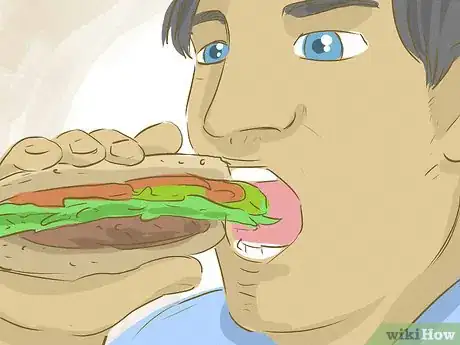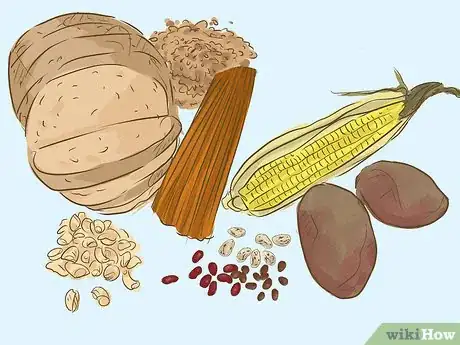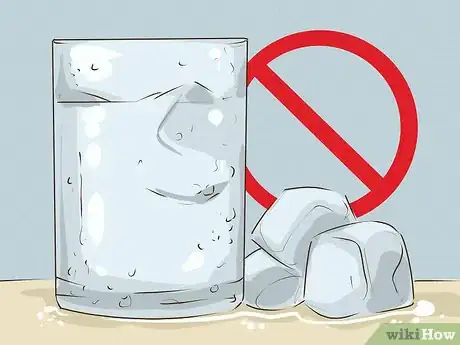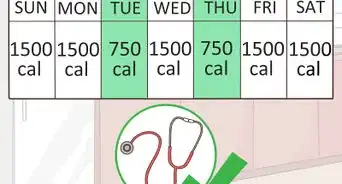This article was co-authored by John Burson. John Burson is a Certified Nutritionist, Licensed Herbalist, and Certified Personal Trainer. With over 25 years of experience, John specializes in helping clients lose weight and live healthier lives. John graduated magna cum laude and received a Bachelor’s degree in Business and Marketing from Grand Canyon University. He has also earned Thumbtack Top Pro honos for three consecutive years.
There are 17 references cited in this article, which can be found at the bottom of the page.
This article has been viewed 941,091 times.
Decreasing your metabolism can be done to gain weight or conserve energy, and is done through changing lifestyle habits. Your metabolism is the rate at which you burn off energy from the food you eat. Slower metabolisms burn energy over a longer period of time than fast metabolisms. There are several ways to slow down your metabolism, mostly by changing your diet and the amount of activity you do every day. Before you try to do this, however, consult a doctor to make sure it is a safe and possible option to consider for your lifestyle and health.
Steps
Calculating your Basal Metabolic Rate
-
1Determine your basal metabolic rate (metabolism at rest). You can find an online calculator, or you can use the following formulas, depending on your gender:
-
2Calculate your total daily calorie needs using a formula known as the Harris-Benedict equation. Once you have calculated your BMR, you can estimate your total calorie needs for different levels of activity. Decreasing your metabolism means you are "turning down" your body's internal furnaces, which lowers your calorie requirements. Use your BMR to make the following calculations. If you:
- Are inactive or exercise rarely: Calories to stay the same weight = BMR x 1.2[1]
- Exercise lightly 1 to 3 days per week: Calories to stay the same weight = BMR x 1.375[1]
- Exercise moderately for 3 to 5 days per week: Calories to stay the same weight = BMR x 1.55[1]
- Exercise actively for 6 to 7 days per week: Calories to stay the same weight = BMR x 1.725[1]
- Exercise intensely every day: Calories to stay the same weight = BMR x 1.9[1]
Decreasing Your Metabolism in Order to Gain Weight
-
1Understand that "slow metabolisms" aren't necessarily responsible for weight gain. If you want to gain weight, go here for a discussion of how to do so in a healthy way. Doctors generally agree that other factors are more responsible for weight gain or weight loss than your metabolism. These factors include:
- How many calories you consume daily.
- How much and how intensely you exercise.
- Your genetics and family history.
- The medications you may be taking.
- Other unhealthy habits such as not getting enough sleep.
-
2Understand that slowing your metabolism might not be the healthiest way to gain weight. Slowing your metabolism can involve some pretty unpleasant things: skipping meals, eating few calories, etc. Proper, medically-sound weight gain often involves:
- Increasing caloric intake. Eating more calories than your body burns in a day.
- Addressing any underlying medical issue that might be causing you to lose weight, e.g. thyroid issues, diabetes, anorexia nervosa.
-
3Skip meals. If you want to decrease your metabolic rate, start skipping meals. This is not a healthy way to lower your metabolism, but it's effective. Skipping meals causes the body to think that it might have to start preparing for famine, causing it to lower its metabolism in an effort to save energy.[2]
-
4Eat fewer calories. When you give your body fewer calories, it compensates by lowering your overall metabolic rate.[2] And it makes sense: with fewer overall calories to work with, your body can't expect to use the same amount of energy that it can when it's getting more calories.
- Note: When you give your body fewer calories, it might start burning muscles or body tissue in order to compensate for the lack of calories it's getting. If you are already skinny, this isn't a good method for weight gain.
-
5
-
6Replace simple carbohydrates (sugar) with complex carbohydrates (starch and fiber) when possible. Studies show that sugars and fruit are digested and absorbed more rapidly than complex carbohydrates, such as bread, producing a rollercoaster of blood sugar with high peaks and low troughs.[12] It has also been shown[13] that the total carbohydrate oxidation over a six-hour period is lower with complex carbohydrates (bread and maize starch) than with sugars.[14]
- Sucrose (table sugar) also contains fructose, while complex carbohydrates are made up exclusively of glucose units. Fructose consumption results in greater thermogenesis (calorie burning) than glucose consumption.[15]
- Choose high-fiber foods such as grains (especially whole grains) and vegetables. High-fiber meals have been shown to reduce thermogenesis (calorie burning) for six hours after eating.[16]
-
7Include nuts and seeds in the diet. Of all the foods you can eat, nuts and seeds, which contain almost no moisture and provide healthful unsaturated fats, have the highest caloric density, packing in the most calories per ounce. Polyunsaturated fats, such as those in nuts, have been shown to be oxidized more slowly than monounsaturated fats.[17] Nuts and seeds are also rich in the amino acid arginine. Arginine is used by the body to make nitric oxide, a gas that has been shown to reduce the metabolic rate.[18] [12] [20]
Decreasing Your Metabolism in a Survival Situation
-
1Dress warmly. Heat loss is a major energy drain, so dress warmly to slow down your metabolism. When you are cold, your body increases the levels of uncoupling protein in your cells. Uncoupling proteins interfere with ATP production, resulting in heat instead of useful energy from the food that you eat.
-
2Huddle with other people if you have company. Move to the warmest area you can find, or build a shelter if you are outdoors.
-
3Lie still. Everything that you do burns calories. Even small things like picking up sticks or skipping rocks. After you have been exercising for a while, your metabolism remains elevated for a period of time, even when you are resting.[23] [24] Every mile that you walk burns 100 calories, and that does not account for the increase in metabolism produced by exercise. Try to sleep if possible.
-
4Do not drink cold water or eat snow. Your body will expend energy to warm up the water.[25] This is energy that you could be saving for a more life-critical task, such as hunting for food for surveying for escape routes.
Warnings
- If you lower your metabolism and continue to take in the same number of calories you were eating before, you will gain weight. Your body does not need as much food with a slower metabolism, and it will store the extra energy as fat.⧼thumbs_response⧽
References
- ↑ 1.01.11.21.31.41.51.6http://www.bmi-calculator.net/bmr-calculator/bmr-formula.php
- ↑ 2.02.1http://www.dummies.com/how-to/content/behaviors-that-lower-your-metabolic-rate.html
- ↑ “[What could not beauty be lack of]?” Health Care. February 6, 2013. “The person is in a sleep state. The metabolic rate will reach a minimum. The early morning awakening, metabolism will gradually return to normal levels.”
- ↑ William J. Evans, William Evans, and Gerald Secor Couzens (2003), AstroFit: The Astronaut Program for Anti-Aging, Simon and Schuster, pg. 77, ISBN 9780743216821. “Your metabolism, which is measured in the lab as the number of calories per minute per kilogram of body weight you use, is lowest upon awakening and highest during vigorous activities.”
- ↑ 6.06.1Thomas M. S. Wolever (2006), The Glycaemic Index: A Physiological Classification of Dietary Carbohydrate, CABI, pg. 65, ISBN 9781845930516. "Indeed, blood glucose responses elicited by pure sugars and fruits suggest rapid absorption because the blood glucose concentration rises more quickly and falls more rapidly than after bread (Wolever et al., 1993; Lee and Wolever, 1998)."
- ↑ Daly ME et al. Acute fuel selection in response to high-sucrose and high-starch meals in healthy men. Am J Clin Nutr. 2000 Jun;71(6):1516-24.
- ↑ Tappy L et al. "Comparison of thermogenic effect of fructose and glucose in normal humans". Am J Physiol. 1986 Jun;250(6 Pt 1):E718-24.
- ↑ Jie Kang, Bioenergetics Primer for Exercise Science, pg. 147. "The TEF (thermic effect of food) was 6.9% with the lower-fiber meal, 5.1% after the glucomannan-supplemented meal, and 4.5% after the high-fiber meal. These effects were particularly apparent from 2 to 6 h after ingestion."
- ↑ Jones PJH. Pencharz PB, Clandinin MT. “Whole body oxidation of dietary fatty acids: implications for energy utilization.” Am J Clin Nutr. 1985 Nov;42:769-777.
- ↑ Shen W, Hintze TH, Wolin MS. “Nitric oxide. An important signaling mechanism between vascular endothelium and parenchymal cells in the regulation of oxygen consumption.” Circulation. 1995 Dec 15;92(12):3505-12.
- ↑ [Xie YW, Shen W, Zhao G, Xu X, Wolin MS, Hintze TH. Role of endothelium-derived nitric oxide in the modulation of canine myocardial mitochondrial respiration in vitro: implications for the development of heart failure. Circ Res. 1996;79(3):381–387.
- ↑ Shen W, Xu X, Ochoa M, Zhao G, Wolin MS, Hintze TH. “Role of nitric oxide in the regulation of oxygen consumption in conscious dogs.” Circ Res. 1994 Dec;75(6):1086-95.
- ↑ Gavrilova O et al. "Torpor in mice is induced by both leptin-dependent and -independent mechanisms". Proc Natl Acad Sci U S A. 1999 Dec 7;96(25):14623-8.
- ↑ Laura Batmanian, Ward Worral Batmanian, Simon Worrall, Justin Ridge (2009), Biochemistry for Health Professionals, Elsevier Australia, pg. 182, ISBN 9780729538749. "The total deficiency of thyroid hormones can reduce basal metabolic rate up to 50%, while excessive production of thyroid hormones can cause the basal metabolic rate to increase by 100%."
- ↑ http://www.nytimes.com/2011/04/19/health/nutrition/19best.html?_r=0
- ↑ http://www.ncbi.nlm.nih.gov/pubmed/21311363
- ↑ http://www.nbcnews.com/id/41721690/ns/health-diet_and_nutrition/#.UTFW-esjoVk
- ↑ Maurice Edward Shils and Moshe Shike, Modern Nutrition in Health and Disease, pg. 143. "Cold- and heat-induced thermogenesis refers to the increase in EE [energy expenditure] that is induced at ambient temperatures below or above the zone of thermoneutrality. Studies consistently suggest that low-normal temperatures of 20 to 22°C and high temperatures of 28 to 30°C are associated with an increase in sedentary EE of 2 to 5% compared with temperatures of 24 to 27°C."
- ↑ Calvin Ezrin, John O. Godden, Robert Volpé, Systematic endocrinology, pg. 112, 1979.
- ↑ 21.021.1Louis Sanford Goodman, Alfred Goodman Gilman (1996), Goodman and Gilman's the pharmacological basis of therapeutics (9th ed.), McGraw-Hill, pg. 1402, ISBN 978-0-07-026266-9.
- ↑ Food and Nutrition Board, Institute of Medicine, Dietary Reference Intakes for Energy, Carbohydrate, Fiber, Fat, Fatty Acids, Cholesterol, Protein, and Amino Acids (Macronutrients), pg 118.

















-Step-12-Version-2.webp)





















































